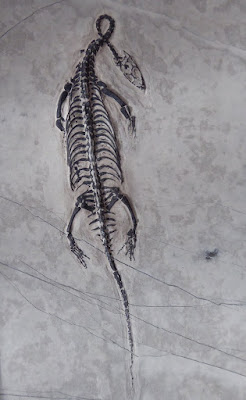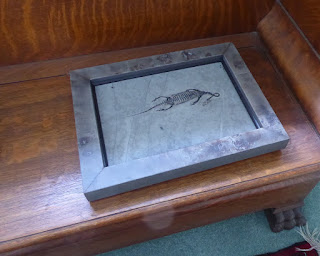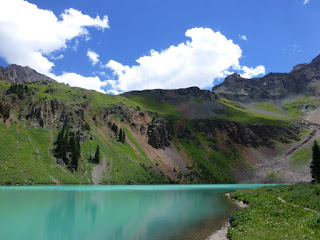 Meet my little buddy Mr. Sneffels. Mr. Sneffels is from China but he doesn’t have a Chinese name because I adopted him and named him myself, after Mt. Sneffels, which I was hiking on the same day I picked him up. Mr. Sneffels is a Keichousaurus hui, and the very youngest he could be is about 201 million years old. Whoever was remaining of the Keichousaurus clan cleared out then, during the Triassic-Jurassic extinction event. May not have been a good idea, but all the kids were doing it.
Meet my little buddy Mr. Sneffels. Mr. Sneffels is from China but he doesn’t have a Chinese name because I adopted him and named him myself, after Mt. Sneffels, which I was hiking on the same day I picked him up. Mr. Sneffels is a Keichousaurus hui, and the very youngest he could be is about 201 million years old. Whoever was remaining of the Keichousaurus clan cleared out then, during the Triassic-Jurassic extinction event. May not have been a good idea, but all the kids were doing it.
What a pity, though. He was a marine lizard. He paddled around marshes with his big paddly arms. Had to be cute as the dickens. They even think these guys were born live rather than being shot out in egg form. They’ve found fossilized adult lizards with tiny versions nestled in the pelvic regions, which either means the animal died pregnant, or the tiny version died by being sat on and the larger one perished of grief. Nobody is real sure what caused half of the world’s species to die out 201 million years ago, but the best guess is it was another climate change deal. That stuff is serious. There’s only so much carbon in the world and it moves around over time: in any given era, it might be mostly underground bound up in rocks, or it might be in the air. The first way is good for us and the other way is good for giant termites, and the planet doesn’t care either way, so it’s something to consider if you’re in the process of pumping it out of the ground and into the air. The Carbon Perp at the T-J event was likely to be volcanoes.
This particular kind of fossil is really common. Many of them display the pretzeled neck that you see on poor Mr. Sneffels. It was explained to me that it is a natural event that happens upon death, some sort of rigor mortis thing, although it seems equally likely to me that the unfortunate lizard might have just been looking back to see what got him.
 I brought Mr. Sneffels back from the fossil orphanage in Ouray, Colorado. I might have paid too much for him; it’s hard to tell. It’s not the kind of thing Bill Cullen asked about on The Price Is Right. But I’d been in the place many years earlier and was sorely tempted to buy one then, and didn’t, and as soon as I got home I regretted it. So this time I snapped him up. And I haven’t regretted it. I like him bunches. I even had him professionally framed, which I rarely pop for, because I didn’t know how to frame a rock. And I still haven’t hung him on the wall.
I brought Mr. Sneffels back from the fossil orphanage in Ouray, Colorado. I might have paid too much for him; it’s hard to tell. It’s not the kind of thing Bill Cullen asked about on The Price Is Right. But I’d been in the place many years earlier and was sorely tempted to buy one then, and didn’t, and as soon as I got home I regretted it. So this time I snapped him up. And I haven’t regretted it. I like him bunches. I even had him professionally framed, which I rarely pop for, because I didn’t know how to frame a rock. And I still haven’t hung him on the wall.
He’s heavy, but that’s not the problem. Framing hardware is plenty adequate for his weight. But every time I think about taking him off the top of the desk he’s lying flat on and hanging him on the wall, I think about how he’s going to come crashing down when we get our 9.0 earthquake. I can’t bear it.
Which is silly. It’s like dreading a flood because it will make you look all pruney. Besides, when we do get our 9.0 earthquake, he’s going to go sailing off the desk he’s on. Or our house will come crashing down on him, or the neighbor’s house will. And it’s even remotely possible that when I’m being jerked back and forth and the house is pancaking all around me, I won’t even give Mr. Sneffles a thought. It’s possible that there are things I care even more about than Mr. Sneffles in the event of an earthquake, including, oh, off the top of my head, my piano and my self.
 |
| Hiking Mt. Sneffels |
But I am strangely moved by having custody of a 200+ million-year-old marine lizard. It seems just wrong to have him have gotten this far and then go to smithereens. I feel like I owe him a shot at eternity. But ain’t none of us got that. And maybe the very glory of geology is served by this. Maybe a piece of petrified marsh soil pocked with neat lizards and thrust once again into the daylight after 200 million years deserves to be ground to dust by a major tectonic upheaval. Maybe it’s the best ride we can hope for on our still-living, still-churning planet.
Phew! Thank the -unbelievable-sky-fairy! I thought you's found him some local hike, like Shasta or Hood or Rainier. Which kinda bothered me. But the fact that he's a Coloradan (Coloradian?) make it easier to grasp.Real ancient rocky stuff, see, not recent foresty stuff.. Oh, never mind.
Actually he's Chinese-Coloradan.
If he sparks joy in you when you look at him, then I am glad that you bought him, no matter the price. It seems that, no matter how much money one has in the bank, it's going to be worthless sooner than we expect. Best to enjoy life now, because the present is all that we can be sure of.
Unless we's lucky enough to get petrified!
So two things to worry about in one post! Huge earthquake and the next extinction.
But I'm glad you get to spend time with the old guy—and I do think he was intentionally looking back.
It's possible he had an itchy tail. From some parasite that eventually did him in. Yeah. That's it.
I can see how something like that would be an important touchstone…a link to a long time ago and a reminder that we will not be remembered as long.
Well I don't know about that. I'm revising my funeral plans to include a laying-out on a mudflat just before a drought.
You would be harder to frame though. And the perfect spot would be hard to find…
Plus I have enough trouble with my neck without having it all bent up for eternity.
I don't know about the purchasing power required to secure Mr Sneffels, but you are absolutely priceless!
We'll have to assume that, because nobody's offered anything for me.
The answer is simple – bury Mr. Sneffels, frame and all, in your backyard. You're welcome.
Seriously, that is an awesome thing to be able to look at whenever you want. It was worth every penny, even though I don't know how many pennies that would be.
Fortunately, I also do not remember how many pennies that was.
Your post made me think of something slightly other, not unusual.
I grew up in Bend, as you know, 50's and very early 60's. A hobby, or pastime, whatever you will, was to drive east on a weekend, towards Burns, but only 20-50 miles. Dirt roads frequently led off to the left and right, and off those other, less formal roads, sometimes needing 4X4.
We'd see a 'butte, or some higher ground and just look around for obsidian chips. If we found some, we'd dig. We'd find arrowheads and spearheads. It was BLM land, as is much of the area out there, and there was no prohibition. It was a pretty normal family activity.
Now, the comparatively small collection of a couple hundred, maybe less, are a federal crime. One of my last trips to Bend I stopped in Warm Springs on my way down, and gave them around 40 of the better ones, fewest flaws.
They nodded, shrugged and told me if I wanted they'd take them, but they had hundreds of thousands of the same.
Interesting how an artifact can suddenly be a reason to peep out the blinds.
Che
My sister was a pebble pup and then a rockhound and ended up with a Master's in geology, and on our family vacations we stopped by every roadcut we could and dug. She always knew what we were looking for and it was a great scavenger hunt for me, the Baby. The Green River formation was the big prize for fossils. You aren't even allowed up there now.
Fossicking around in much of Australia is verboten these days, because of the many, many aboriginal "sacred" sites. Move as much as a pebble and you're disrespecting their heritage. There's all that watching out for deadly brown snakes too.
Still, Mr Sneffles is a cutie. Maybe you could embed him somewhere safe that you are likely to grab and take when the 9.0 has you running for shelter.
I've been thinking about this. And I've been thinking I'm okay with him busting into pieces as long as they're not on my head. I want to hang him kind of next to my bed, and I always assume I'll be in bed when the big one hits–the question is, if he gets launched off the wall, will I be launched in the same direction at the same time, and thus we will remain separated? Or will the bed have more gription on the carpet and he really will land on my head? Actually, there's a spot on the wall a little farther away that might work.
As the proud owner of a trilobite set in a ring, I totally get this. 521 – 240 million years ago, give or take a mil. It's my anti-creationist talisman.
The Permian Extinction! The Big One! Your trilobite is older than my lizard. Still. They're both super cool.
I can't believe you were taken in by the evolutionist hype! All Right-thinking people know that the world was created 6,000 years ago, and those "fossil" things are just junk animals that were drowned in the flood. If they'd been worth anything, they would have crawled onto the Ark. Shame on you for spreading these lies!
(With tongue firmly in cheek, of course!)
Well I don't know if "junk" animals is fair. "Wrong-thinking," perhaps.
I was just wondering, how do you know he's a he, and not a she? Either way — COOL. Seriously awesome.
I don't! I default to "he" because I'm old and raised that way. I am neither proud nor ashamed of this!
It's OK. My much-loved mother-in-law always believed that all dogs were boys and all cats were girls. I miss her.
konveksi jaket kulit
konveksi jaket kulit
toko jaket kulit
toko jaket kulit
konveksi jaket kulit
toko jaket kulit
jaket kulit garut
jaket kulit garut
jaket kulit garut
jaket kulit garut
konveksi jaket kulit
konveksi jaket kulit
jaket kulit garut
jual jaket kulit
jual jaket kulit
jual jaket kulit
jual jaket kulit
jual jaket kulit
jaket kulit asli
jaket kulit asli
jaket kulit asli
jaket kulit asli
jaket kulit asli
pabrik jaket kulit
pusat jaket kulit
pabrik jaket kulit
pusat jaket kulit
pabrik jaket kulit
pusat jaket kulit
pabrik jaket kulit
pusat jaket kulit
pabrik jaket kulit
pusat jaket kulit
Thank you, your article is very good
viagra asli usa